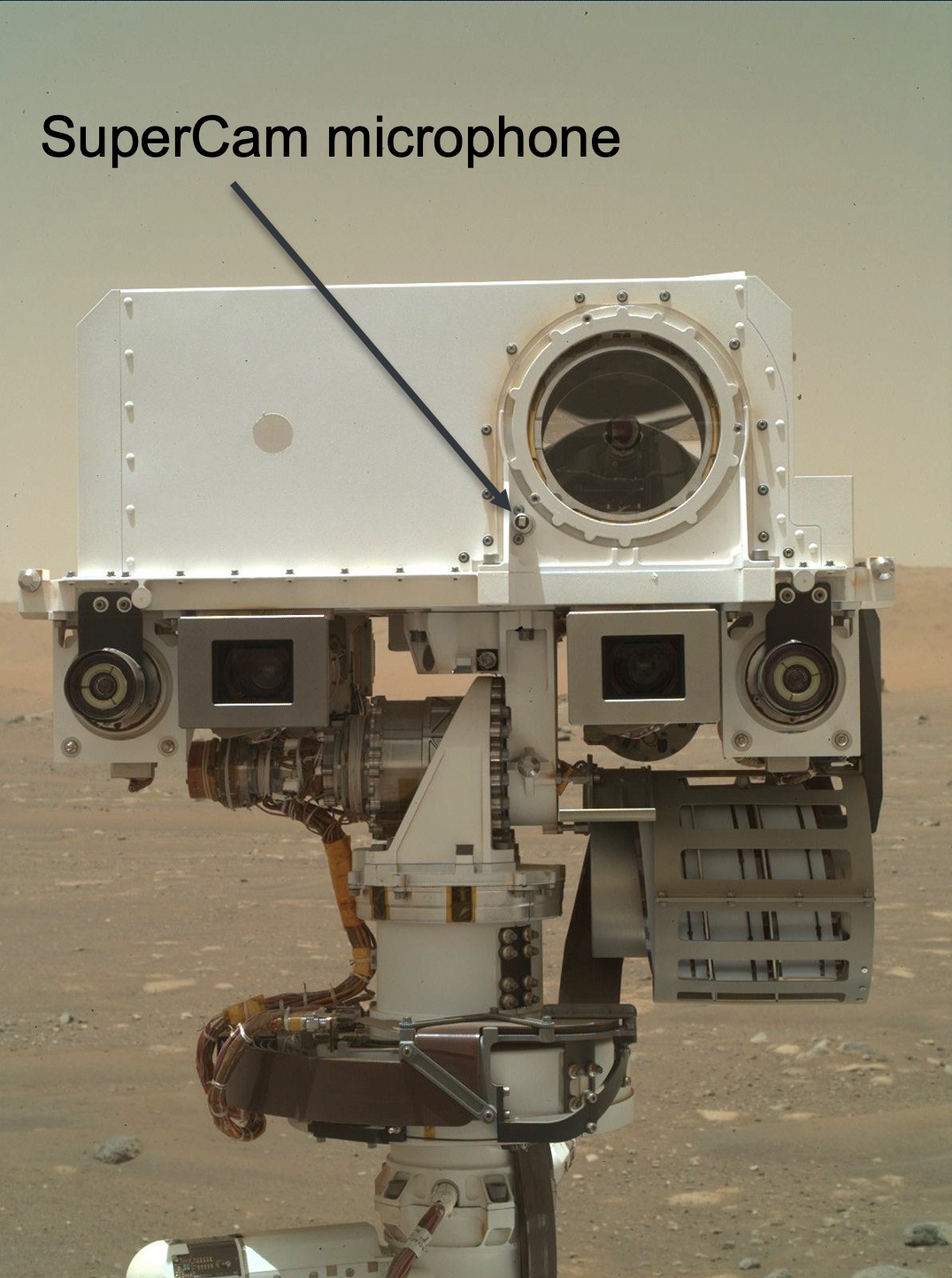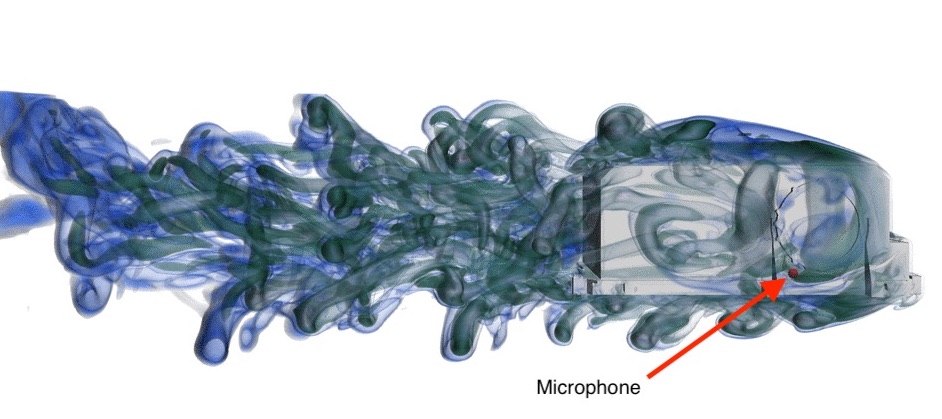Atmospheric Science with the SuperCam Microphone on the Perseverance Rover
- 1Institut supérieur de l'aéronautique et de l'espace (ISAE-SUPAERO), Université de Toulouse, France (naomi.murdoch@isae.fr)
- 2Institut de recherche en astrophysique et planétologie, CNRS, Toulouse, France
- 3John Hopkins University Applied Physics Laboratory, MD, USA
- 4Jet Propulsion Laboratory, CA, USA
- 5Aeolis Research, CA, USA
- 6Space Science Institute, CO, USA
- 7Los Alamos National Laboratory, NM, USA
- *A full list of authors appears at the end of the abstract
Abstract
On 19 February 2021 the SuperCam microphone onboard Perseverance recorded the first ever sounds on the surface of Mars. These recordings of the Martian dynamic pressure fluctuations actually contain a wealth of information about the Martian atmosphere.
Introduction
The Mars 2020 Perseverance rover [1] landed in Jezeero crater on 18 February 2021. The SuperCam Microphone is located at a height of 2.1 m above the ground on the front of the SuperCam instrument (Fig 1; [2,3]). Although the primary science objective of the SuperCam Microphone is to support the SuperCam Laser-Induced Breakdown Spectroscopy (LIBS) investigations by providing additional information about the physical properties of the LIBS targets [4,5], the microphone also has the capacity to provide data for new and important atmospheric investigations. With a bandwidth from 100 Hz to 10 kHz, the overarching atmospheric science goal of the microphone is to characterise the Martian atmospheric dynamics at high frequency, including the diurnal and seasonal evolution.

Figure 1: The SuperCam instrument, including the microphone, on the surface of Mars
Studying the turbulent Martian atmosphere with the SuperCam microphone
Pressure fluctuations in the atmosphere tell us about boundary layer convection, convective cells and vortices, and the inertial and dissipative regimes. Compared with Earth, Martian daytime turbulence is characterised by a stronger radiative control, a lack of latent heat forcing and a reduced inertial range [6].
Wind gustiness, convective vortex activity and the spectral slope of pressure, wind and temperature measurements can be used as indicators of turbulent motion in the atmosphere. These variables exhibit strong diurnal and seasonal variations (e.g., [7-10]). Recent analyses have also shown that wind gustiness on Mars is positively correlated to surface temperature rather than ambient wind speed and sensible heat flux [10].
Previous Martian space missions have provided valuable pressure, wind and temperature data allowing the Martian turbulence to be studied (e.g., [7,11]). The highest frequency atmospheric measurements that we currently have come from the pressure sensor on the InSight mission [12,13]. The InSight pressure measurements show unexpected behaviour. For example, they seem to contradict the theoretical predictions (Kolmogorov theory) for the cascade of the inertial range [14].
With its high sampling frequency, we can use the SuperCam microphone to study Martian turbulence on new, previously inaccessible, scales. From recordings at different local times and over different seasons, the SuperCam microphone can complement the lower frequency MEDA [15] wind speed measurements and provide a window into previously unexplored regimes of Martian atmospheric science.
The SuperCam microphone as a high frequency wind sensor
Pre-mission, in wind tunnel tests, it has been shown that the microphone can be used to estimate the wind speed – a quadratic relationship exists between wind speed and the microphone RMS signal [16]. However, the relationship between the microphone signal and wind speed may be more complex than this simple relationship, and other atmospheric effects (such as atmospheric stability) should also be included in the future.
The dynamic pressure signal measured by the microphone is a combination of the atmospheric dynamic pressure fluctuations and the aeroacoustic fluctuations due to vortex shedding (Fig. 2; [16,17]). Simultaneous MEDA and SuperCam measurements (over 360°) are necessary in order to perform a cross-calibration activity with MEDA in order to produce absolute wind speed estimates. The microphone can also be used with single (not directional) observations to provide relative wind speed estimates, and to study the gustiness in the Martian atmosphere [18].

Figure 2: CFD simulations of vortex shedding around the SuperCam instrument under Martian atmospheric conditions with a wind speed of 5 m/s from the right of this image. The microphone is indicated by the small red sphere on the front of the instrument [16,17]. The blue and dark green areas correspond to the vortices generated around, and in the wake of, the SuperCam instrument
Air temperature measurements with the SuperCam microphone
Combined LIBS and SuperCam microphone operations [4, 19 - 20] can be used to probe the high frequency temperature fluctuations in the Martian atmosphere. Specifically, measuring the propagation time of the acoustic signal produced by the laser gives the sound speed from the ground to the microphone. The sound speed can then be used to derive the ‘acoustic temperature’ - the average of the air temperature over the 2 meters between the microphone and the laser target - for every laser shot (3 Hz). This is potentially important because large thermal gradients just above the Mars surface have been hinted at in previous data [21].
Conclusions
The SuperCam microphone observations allow us to quantify the dynamic pressure spectra, the wind gustiness and the air temperature at high frequency thus providing an opportunity to characterise the Martian atmospheric dynamics in previously unexplored regimes. The SuperCam microphone may also be used for more opportunistic science such as searching for the acoustic signals of convective vortices [22].
References
[1] Farley et al. SSR 2020. [2] Maurice et al. SSR 2021. [3] Wiens et al., SSR 2021. [4] Murdoch et al. PSS 2019. [5] Chide et al. SAB 2019. [6] Spiga et al., SSR 2019. [7] Davy et al., JGR, 2010. [8] Murdoch et al., SSR 2017. [9] Ullan et al. Icarus 2017. [10] Spiga et al. JGR-Planets 2020. [11] Larsen et al. BLM 2002. [12] Banfield et al. SSR 2019. [13] Banerdt et al. Nature Geoscience 2020. [14] Banfield, Spiga et al. Nature Geoscience 2020. [15] Rodriguez-Manfredi et al. SSR 2021. [16] Chide et al. Icarus 2021. [17] Bury et al. EPSC 2019. [18] Stott et al. EPSC 2021. [19] Chide et al. SAB 2020. [20] Chide et al. EPSC 2021. [21] Schofield et al. Science 1997. [22] Murdoch et al. LPSC 2021
N. Murdoch1, D. Mimoun1, A. E. Stott1, B. Chide2, R. Lorenz3, S. Maurice2, M. De La Torre Juarez4, C. Newman5, M. Wolff6, R.C. Wiens7 , C. Alvarez8, S. M. Angel9, D. Banfield10, P. Bernardi11, O. Beyssac12, B. Bousquet13, A. Cadu1, E. Clavé13, E. Dehouck14, O. Forni2, T. Fouchet11, O. Gasnault2, M. Genzer15, M. Hieta15, R. Hueso16, X. Jacob17, G. Lacombe2, N. L. Lanza7, J. Laserna8, J. Lasue2, A. Lepinette18, P.-Y. Meslin2, F. Montmessin19, J. Moros8, S. Navarro18, A. M. Ollila7, P. Pilleri2, P. Purohit8, A. L. Reyes-Newell7, A. Sanchez-Lavega18, S. Schröder20, R. Sullivan10, L. Tamppari4, D. Vogt20, and the Perseverance Acoustics and Atmospherics working groups 1ISAE-SUPAERO, Toulouse, France, 2IRAP-CNRS, Toulouse, France, 3JHU-APL, MD, USA, 4JPL, CA, USA, 5Aeolis Research, CA, USA, 6SSI, CO, USA 7Los Alamos National Laboratory, NM, USA, 8Universidad de Malaga, Malaga, Spain, 9University of South Carolina, SC, USA, 10Cornell, NY, USA, 11LESIA, Meudon, France, 12IMPMC, Paris, France, 13CELIA, Bordeaux, France, 14LGL-TPE, Lyon, France, 15FMI, Helsinki, Finland, 16UPV/EHU, Leioa, Spain, 17IMFT, Toulouse, France, 18CAB, Madrid, Spain, 19LATMOS, Guyancourt, France, 20DLR, Berlin, Germany
How to cite: Murdoch, N., Mimoun, D., Stott, A. E., Chide, B., Lorenz, R., Maurice, S., de la Torre Juarez, M., Newman, C., Wolff, M., and Wiens, R. C. and the The Perseverance Acoustics and Atmospherics working groups: Atmospheric Science with the SuperCam Microphone on the Perseverance Rover, Europlanet Science Congress 2021, online, 13–24 Sep 2021, EPSC2021-516, https://doi.org/10.5194/epsc2021-516, 2021.

